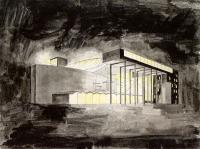Hikawa Shrine Office
Nerima-ku, Tokyo, Japan
The building is a temporary shrine office for the Nerima Hikawa Shrine.
The building is not a temporary structure, but the first step in a six-year programme to rebuild the shrine precincts.
It is planned that the building will be used as a shrine office for about five years until the main hall, worship hall and main office are completed, after which the programme will move to a place for community activities open to the surrounding town.
The architect, the shrine's chief priest, the shrine's supporters, the developer overseeing the project and our design team have worked together to draw up the blueprint.
At the time of opening, the use of the building will be very simple: a place for the distribution of talismans and amulets, a simple office space and a meeting room for the regular general assembly meetings.
On the other hand, the building must be used as a place for the deities to reside while it is being demolished.
In order to maintain the prestige of the shrine as a place where the holy body of the god is housed, and to allow the interior to be used separately from the shrine, we proposed a column-free space made of layered beams of 105 x 150 mm flat cypress wood and 150 x 150 mm cypress posts joined together using the vertical log construction method.
The external floor on the second floor overhangs by one ken (1,820 mm) to provide a stage for a variety of annual events such as bean-throwing ceremonies, taiko drum performances and karaoke competitions, and to create a space under the deep eaves for worshipers.
The support system for this overhang is also a combination of 105 x 150 mm flat cypress timbers used as 'tokyou(traditional Japanese shrine architecture detail)' to maintain the shrine-like character of the building.
In addition, an existing non-conforming retaining wall was approaching the neighbouring property to the north and, following consultation with the Government, we were able to obtain a mitigation measure for the separation distance from the boundary by installing a structure that could be assessed as a retaining wall on the side of the proposed building.
The north side of the foundation is raised by the height of the storey and the beams supporting the second storey are crossed over the timber columns on the south side and the RC wall (t=250) on the north side.
In the east-west (longitudinal) direction, the completely symmetrical composition creates a certain dignity, while in the north-south (transverse) direction, the unique expression of the structure, created by the asymmetry of the structure, is directly exposed in the interior.
The building also relies heavily on donations, some of which are in-kind.
In fact, the wood for the finishing and the stones for the exterior were donated by a local construction company that is usually involved in building temple precincts.
The fact that we received contributions not only in money, but also in kind, is one of the achievements of using an open construction method that does not rely on special techniques, but only uses ordinary wood.
We hope that the building will become the kind of architecture where everyone in the town can think of it as a building they built, and where they can continue to be involved with the building not only as users, but sometimes as builders.
- Architects
- Kenta SANO and Associates, Architects
- Location
- Nerima-ku, Tokyo, Japan
- Year
- 2023









